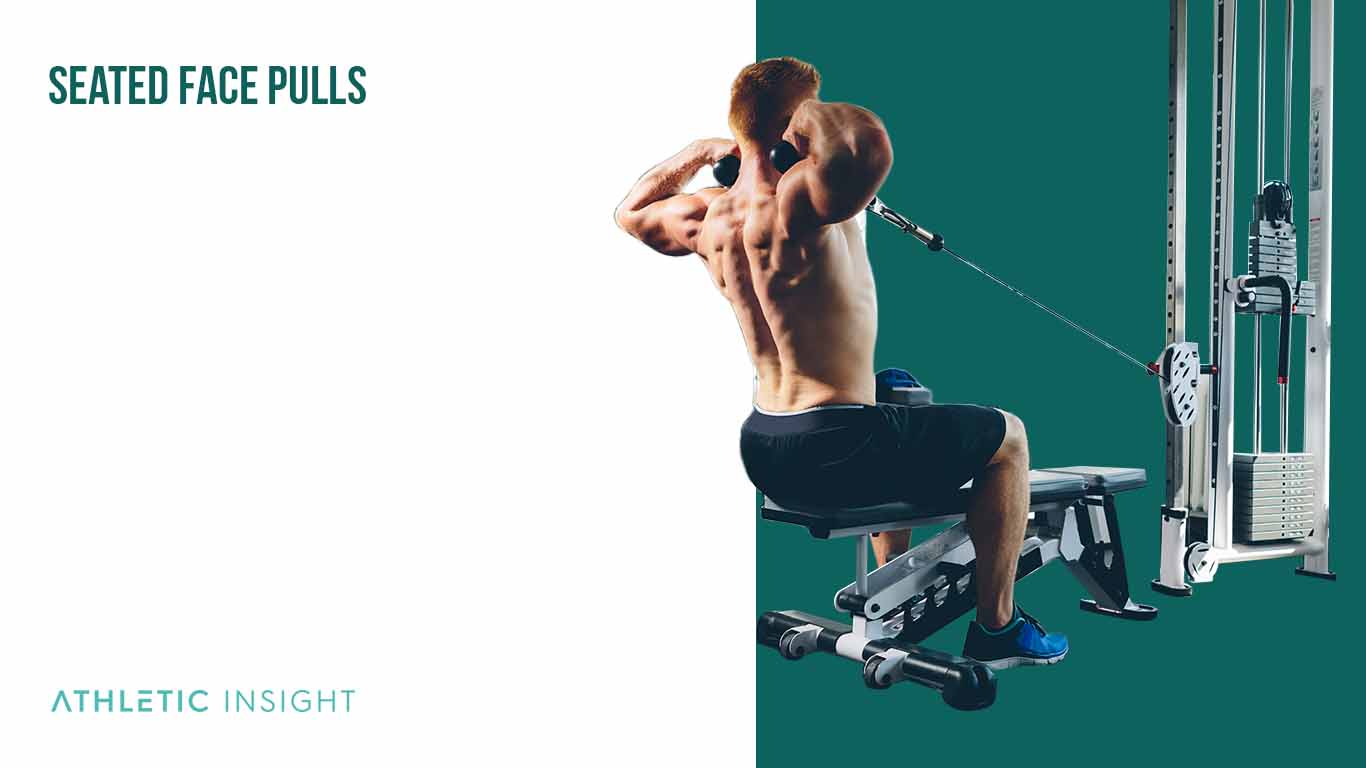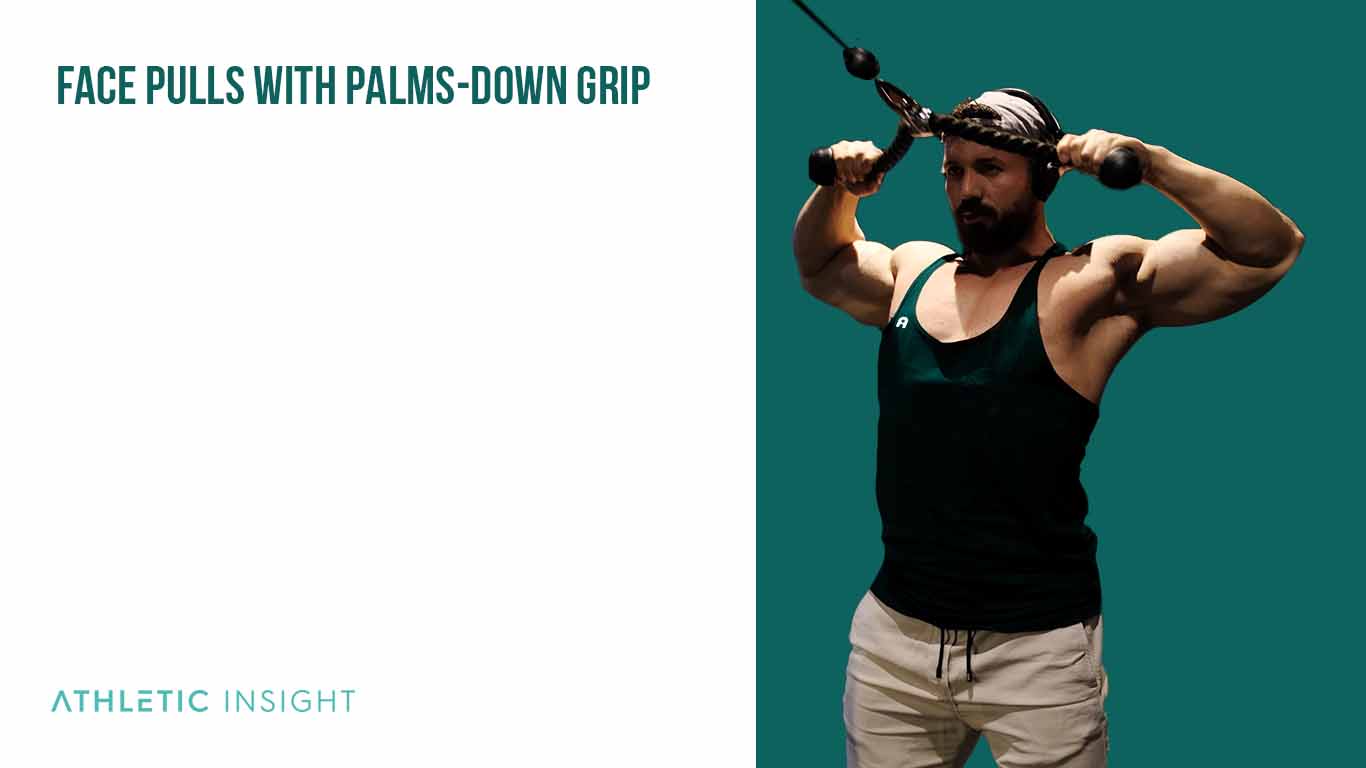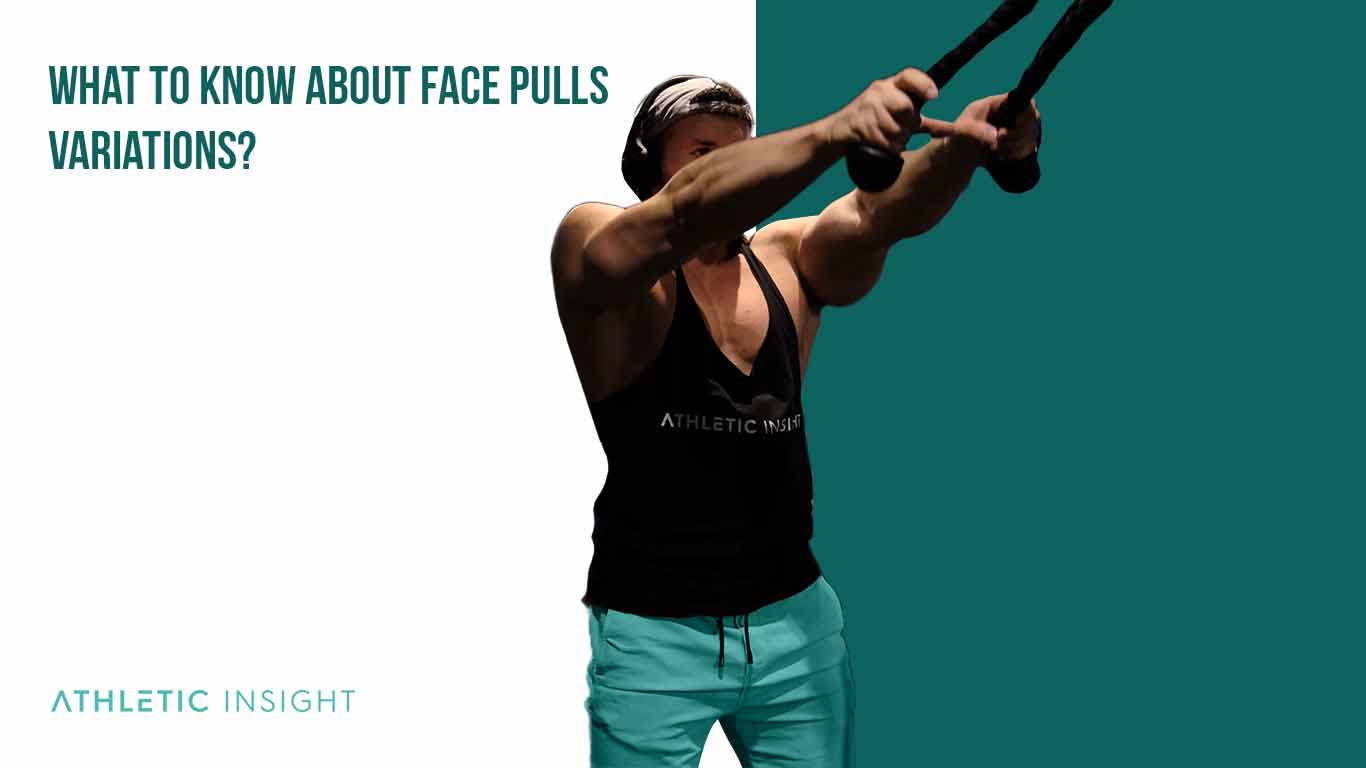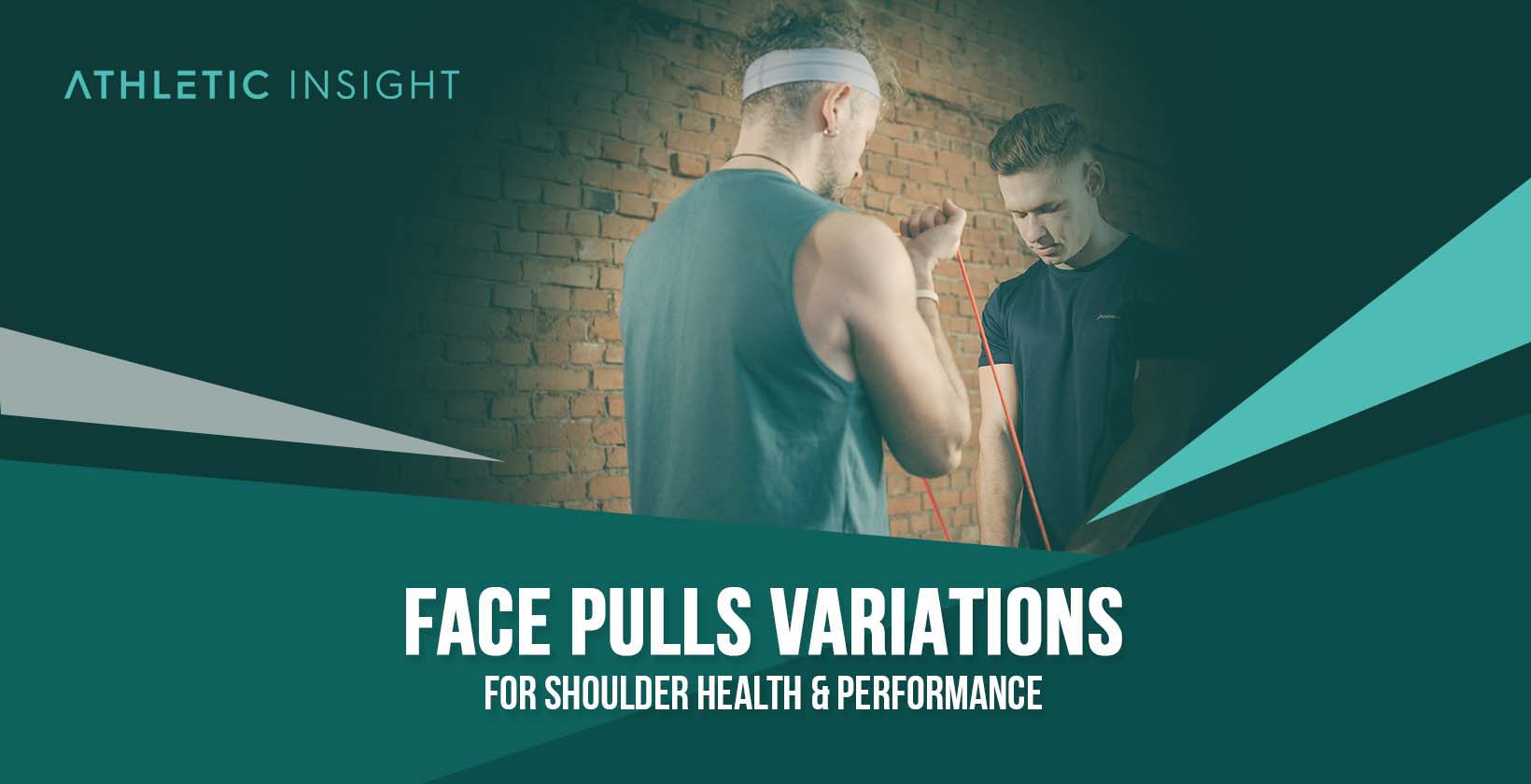Face pulls work the shoulders, primarily the rear deltoids, to build strength, mass, and stability. The traditional exercise utilizes an adjustable cable machine, but some variations use different equipment or form. All face pull variations target the rear delts but allow athletes to engage the muscles from unique angles to alter the workout and emphasize surrounding muscle groups.
These exercises are important because they engage the muscles around the shoulder that allow athletes to perform many common and complex movements. Though the face pull exercises primarily target the rear deltoids, they also engage the rhomboids and traps to improve stability through the shoulders and upper back.
The face pull exercise is a classic exercise for all lifters, including strongmen, bodybuilders, and athletes. It’s especially helpful for athletes who put a lot of stress on their shoulders because face pulls improve stability.
Beginners usually start with about 20 to 30 pounds, but more confident people can face pull as much as 120 pounds. Though advanced athletes can benefit from face pull weight variations, it’s most important to maintain proper form throughout each rep and set.
These are the face pull variations.
- Seated Face Pulls
- Bodyweight Face Pulls
- Chest Supported Face Pulls
- Face Pulls with Hammer Grip
- Face Pulls with Palms Down Grip
- Cable Shoulder Un-Messer-Upper
- 1-Arm Face Pulls
- Face Pulls with Dual Ropes
- Band Face Pull-Apart
- Half-Kneeling Face Pulls
This exercise traditionally uses a cable machine but there are some kettlebell face pull variations. For fans of trap bars, there is no trap bar face pull variation.
1. Seated Face Pulls
The seated face pull is a face pull variation focused on the deltoid muscles and stabilizing the core for athletes of all specialties. By sitting, athletes of all genders take the lower body out of the equation and can focus on isolating the target muscles.

There are a few alternatives for the seated face pull. Some athletes sit on the ground and pull downward from the cable machine, while others use a rowing machine or weight bench to create an eye-level setup. These alternatives allow athletes to engage the deltoids from different angles to work the muscles differently for a balanced result.
Seated face pulls are excellent for athletes recovering from lower-body injuries and those who need to add variety to a workout. It’s also an excellent choice for lifters who need to work on learning proper form with the upper body.
The most common mistakes with seated face pulls are using too much weight and improper form. These mistakes are often related because lifting excessive weight typically results in breaking form. For a more efficient workout, try using less weight and focus on perfecting the proper form before advancing. Further, try increasing the number of reps before adding more weight.
This is a beginner-friendly exercise, though intermediate and advanced lifters can make gains with this highly-focused variation.
The seated face pull is a class face pull variation. It has a few variations, primarily adjusting the angle of the cable from eye level to a higher level. However, athletes can also use resistance bands, dumbbells, or kettlebells.
2. Bodyweight Face Pulls
Bodyweight face pulls are a face pull variation focused on developing the deltoids while improving core strength and overall balance for advanced athletes in all areas. It’s a compound exercise that requires the athlete to pull most of their body up and down.
Advanced athletes of all genders can make an impression by performing this variation at the gym with perfect form. It’s ideal for building the delts while engaging the abs, traps, rhomboids, biceps, triceps, and forearms throughout the exercise.
Alternatives to bodyweight face pulls include pushups, pullups, and chin-ups.
This variation is excellent for core strength and balance. It’s ideal for mixing up an upper-body routine and increasing strength.
The most common mistake for this variation is attempting it without sufficient strength and balance. It’s not effective if the athlete cannot lift enough of their body to achieve the proper form. Athletes should focus on other variations, including the standard face pull, before attempting bodyweight face pulls. Additionally, it helps to put a soft mat or cushion beneath the head and shoulders in case the athletes lose their grip.
This variation is not for beginners. It is best for intermediate to advanced lifters that can confidently hold their own weight.
The bodyweight face pull is an advanced face pull variation. Sometimes known as Aussie rows, bodyweight face pulls have two variations. Athletes can fully extend their legs or bend their knees to make things a little easier by providing some leverage and stability. Both alternatives allow athletes to isolate target muscles and focus on feeling the stretch.
3. Chest Supported Face Pulls
The chest supported face pull is a face pull variation focused on the deltoid muscles for building mass, especially for bodybuilders and strongmen. Athletes of all genders who want to focus on building the shoulders will appreciate the chance to offset the use of other muscle groups, primarily the core. By supporting the chest, athletes can focus on working just the delts.
Alternatives to chest supported face pulls would include chest supported rows and a bent-over fly. The alternatives focus on the same muscles from similar angles. However, they are different exercises that can help lifters mix up their routines while engaging the delts.
The most common mistake with chest supported face pulls is using too much weight. Packing on the weight might look cool, but it’s the surest way to develop poor form and open the door to injury. To avoid these issues, choose lighter weight settings and focus on maintaining the proper form. Lifters should feel the tension in the muscles, even with lighter weight.
This variation is beginner-friendly, though intermediate and advanced lifters can make significant gains by focusing on the delts.
Chest supported face pulls are a classic face pull variation. Lifters can vary the amount of weight they use and have some freedom to adjust the angle they lift at, allowing them to target the delts from different angles.
4. Face Pulls with Hammer Grip
The face pull with hammer grip is a face pull variation focused on the deltoids and grip strength for athletes, bodybuilders, weightlifters, and strongmen. Athletes of all genders can isolate the delts in a unique way by shifting the grip. This variation provides a deeper motion because it grants more range at the innermost point.
The only alternatives to this exercise are the other variations on this list. While it is similar to some of the rows, it engages the shoulder muscles and joints differently.
Athletes should consider using the face pull with a hammer grip to gain a little more rotation at the end of the movement. However, it may not be the best option for those with a history of shoulder injury.
The most common mistake with this variation is using too much weight. Most athletes can’t maintain proper form through the innermost point unless they drop down in weight from the traditional face pull. Further, lifters need sufficient grip strength to gain that extra rotation at the end of the motion. It might help to work on grip strength before advancing to this variation.
Given the need for strength and mastery of form, this variation is best for intermediate to advanced lifters. Beginners may not have the command of their body, flexibility, or strength to manage the full motion.
The face pull with a hammer grip is a weightlifting face pull variation. This variation helps lifters develop rounded shoulders, improve grip strength, and work the forearms. There are no alternatives that accomplish quite the same results.
5. Face Pulls with Palms-Down Grip
Face pulls with a palms-down grip is a face pull variation focused on strengthening the deltoids for weightlifting, bodybuilding, and strongmen. Since the palms-down grip can reduce the range of motion for some lifters, it’s best for men and women who have enough flexibility and strength to manage the shift.

The palms-down grip makes this variation look a lot like a row, but the lifter pulls toward the face instead of the chest. The slightly different angle works the delts and engages the upper back muscles at the end of the motion.
Lifters with a good shoulder range of motion who want to increase strength can typically handle more weight with this variation. It’s ideal for packing on mass and increasing strength faster.
The most common mistake with this variation is using incorrect form. Athletes who lack the range of motion and flexibility to complete this exercise should avoid it or work up to it. Starting with other face pull variations and working on shoulder flexibility and stability could make this one possible in time.
This variation is an intermediate to advanced exercise that requires a good range of motion and shoulder flexibility. The face pull with a palms-down grip can be dangerous for those without sufficient deltoid strength because it can cause damage, including strains and dislocations.
Face pulls with a palms-down grip are a bodybuilding face pull variation. There are no variations other than the ones on this list.
6. Cable Shoulder Un-Messer-Upper
The cable shoulder un-messer-upper is a face pull variation focused on the deltoids for athletes building mass, especially bodybuilders and strongmen. Athletes of all genders will appreciate the series that takes the delts from hard to easy in one comprehensive exercise.
There are no alternatives that work the delts as much from so many angles to create tension in all the right ways. This variation is the exercise for serious lifters who need a challenge and aren’t afraid to work for it.
The most common mistake with the cable shoulder un-messer-upper is using too much weight to manage proper form throughout the exercise. It’s an intense ride for the shoulders that should only be undertaken by intermediate and advanced lifters who possess the strength and control to handle it. Be careful to use slow, controlled motions and sufficient pauses at the top and bottom of each rep.
The cable shoulder un-messer-upper is an advanced bodybuilding face pull variation. It works the delts through a full range of movements and motions that build mass fast.
7. 1-Arm Face Pulls
The 1-arm face pull is a face pull variation focused on isolating the deltoid muscles for all athlete types. Lifters of all genders who need to improve muscle imbalances in the shoulders can incorporate the 1-arm face pull to level things out.
The only alternatives for this variation are on this list, though there are plenty of one-arm exercises to improve muscle imbalances in the arms and shoulders, including military press with a dumbbell and overhead presses.
The most common mistake is using too much weight on the pulley machine because it’s different working one shoulder at a time. Start lighter and start by increasing reps to perfect the form before adding weight.
This variation is beginner-friendly and might help athletes returning from injuries to strengthen their shoulders.
The 1-arm face pull is a classic face pull variation. It focuses on one shoulder instead of both and usually serves to improve unbalanced deltoids.
8. Face Pulls with Dual-ropes
The face pull with dual-ropes is a face pull variation focused on the deltoid muscles for all athletic types. This variation is especially useful for any lifters with broad shoulders and wide-set clavicles, so it’s typically more common for men.
The alternatives are other variations on this list, or possibly a variation of the fly. The face pull with dual-ropes simply takes the traditional face pull deeper by allowing a wider range with more mobility as the lifter pulls toward the face.
The most common mistake with this variation is using too much weight or attempting it with sore or injured shoulders. Because the dual ropes allow lifters to widen the movement, it can be challenging for those with shoulder impingements or limited range of motion. It might be best to avoid performing this variation if there is a history of shoulder injury. At least start with a lighter weight until mastering the proper form.
This is a beginner-friendly variation provided the lifter has sufficient shoulder flexibility and strength to correctly perform the exercise.
The face pull with dual-ropes is a classic face pull variation. Much like the chest-supported face pulls, this one focuses on different angles of your shoulder strength which are excellent for daily strenuous activities. This variation is also similar to the hammer grip, as your grip will change, targeting different shoulder muscles. But you get the added benefit of having a wider range with the rope.
9. Band Face Pull-Apart
Band face pull-apart is a face pull variation focused on warming or cooling down the deltoids and traps for athletes at any level, gender, or specialty. It is the ideal choice for lifters who have resistance bands but not cable machines, making it convenient to perform almost anywhere.
The only alternatives would be other variations on this wrist or perhaps some forms of rows. Given that it requires a resistance band, there are two ways to practice this variation. Secure the resistance band around a pole or other machine and then perform the classic face pulls using the band.
The other option is to wrap the band around the foot or feet and then pull the band upwards, starting at the knees. Using the feet engages the legs in addition to the trapezius and deltoid muscles.
It’s not easy to make mistakes with this variation because it’s just a resistance band. However, keeping a good grip on the band is crucial to avoid injury from snapping it. Some athletes opt for chalk if their hands are too sweaty for the band.
The band face pull-apart is a classic face pull variation. It is beginner friendly and a popular, accessible variation of the traditional face pull.
10. Half-kneeling Face Pulls
Half-kneeling face pulls are a face pull variation focused on deltoid and core muscles for all types of athletes. Lifters of all genders and skill levels can benefit from the half-kneeling face pull because it targets the delts and core while improving lower body stability.
The alternatives are other variations from this list, including some seated rows. It’s an ideal choice for those who prefer a seated face pull but lack the equipment.
The most common mistake with this one is using poor form. Kneel on a soft but stable surface to avoid bruising and pain without compromising balance. Also, try a strongman grip for better control.
This variation is great for beginners that aren’t confident in their shoulder strength.
Half-kneeling face pulls are a classic face pull variation that adds an element of core development and lower body stability. It’s helpful for beginners who want to learn the proper technique.
What to Know About Face Pulls Variations?
Facts about Face Pulls alternatives are listed below.

- Muscle Growth: Face pull alternatives can benefit certain muscle groups better than face pulls by targeting the delts from different angles, like a seated face pull or bodyweight face pull.
- Build Strength: Face pull variations are often more beneficial than the standard face pull exercise because they can target wider ranges and more muscles. It’s also easier to vary weight and reps to isolate muscles at various points in the exercise, like the cable shoulder un-messer-upper.
- Improve Stability: Many face pull variations work on whole body stability more than the traditional face pull. Half-kneeling, 1-arm, and dual ropes all challenge the core and lower body to engage throughout the workout, more so than the standard face pull.
Adding face pull alternatives into a workout provides athletes with some variety while encouraging them to engage the muscles differently. For example, some variations take the pull deeper while others address the delts from multiple angles to create more tension.
What Are the Common Mistakes in Doing the Face Pulls Variations?
The most common mistakes when doing face pull variations are using too much weight and overextending the shoulder.
- Overextending or over-rotating the shoulder can lead to injury and even dislocation. It’s important to follow the proper form and use a manageable weight to maintain control over the equipment and the body.
- Using too much weight is a critical mistake. It’s always better to start lighter and gradually work up, but failing to maintain proper form can prevent an athlete from properly engaging the muscles and even cause an injury.
Which Type of Face Pulls Variation is Beginner-friendly?
The seated face pull is a face pull variation that is beginner-friendly. It allows the beginning athletes to master the proper motion of the shoulders without worrying about balance. Lifters of any age, gender, or sport can benefit from the seated face pull.
Alternative options would be the half-kneeling or banded face pull-apart because these are the safest and typically done with very little weight and high reps. They also teach athletes proper form.
The most common mistake is not using the proper form. It is better to go slow and steady to master the proper technique before moving on to more weight or advanced variations.
Which Type of Face Pulls Variation is Good for Weightlifters?
The cable shoulder un-messer-upper is the best face pull variation for weightlifters of all genders. The exercise engages the delts from multiple angles and focuses on strengthening the shoulder. This variation challenges the lifter to push themselves through various levels and digs deeper to create tension throughout each rep.
The most common mistake with this variation is using improper form. Lifters should not attempt it until they have mastered the proper technique for traditional face pulls. Additionally, it’s best to start with a lighter weight to learn the new motions before packing on more.
This variation is best for intermediate to advanced weightlifters.
Which Type of Face Pulls Variation is Good for Athletes?
The 1-arm face pull is a face pull variation that is good for athletes. Lifters of all skill levels and genders can focus on strengthening the dominant arm or even out the muscle in their weaker arm.
Using too much weight is the most common mistake for this variation because it’s different when using only one arm to lift. Aside from dropping the weight to a manageable level, lifters should focus on using slow, controlled movements to feel the tension in the delts at each stage.
The 1-arm face pull is beginner friendly and a popular choice for mastering form and improving strength.
Which Type of Face Pulls Variation is Good for Bodybuilders?
The cable shoulder un-messer-upper and bodyweight face pulls are face pull variations that are good for bodybuilders. These variations challenge the lifters in new ways and require them to work the delts from different angles. Additionally, both variations work with other muscle groups and improve overall balance.
The most common mistake is trying the exercises before an athlete possesses the strength and skill to do them. Master the traditional face pull and other variations before attempting these more advanced variations.
Advanced athletes of all genders can perform this variation when they have sufficient strength and mastery of the traditional face pull.
Which Face Pulls Variation Is Safer?
The seated face pull is the safest face pull variation. Athletes of any gender and skill level can perform it because it doesn’t require as much overall body strength or stability. It’s an excellent way to work the shoulder muscles safely while mastering the proper technique.
It is possible to make a common mistake with this exercise if an athlete takes on too much weight. Executing proper technique is more important than lifting excessive weight. Lifters should start light, focus on form, and stick with slow, controlled motions.
The seated face pull is a beginner-friendly exercise.
What Are the Alternatives to Face Pulls Exercises?
Though nothing accomplishes quite the same thing as a face pull, some face pull alternatives can work the deltoids. Some of the best face pull alternatives include:
- Dumbbell row
- Lateral pulldown
- Rear cable fly
- Rear delt dumbbell fly
- Pullups
- Pushups



